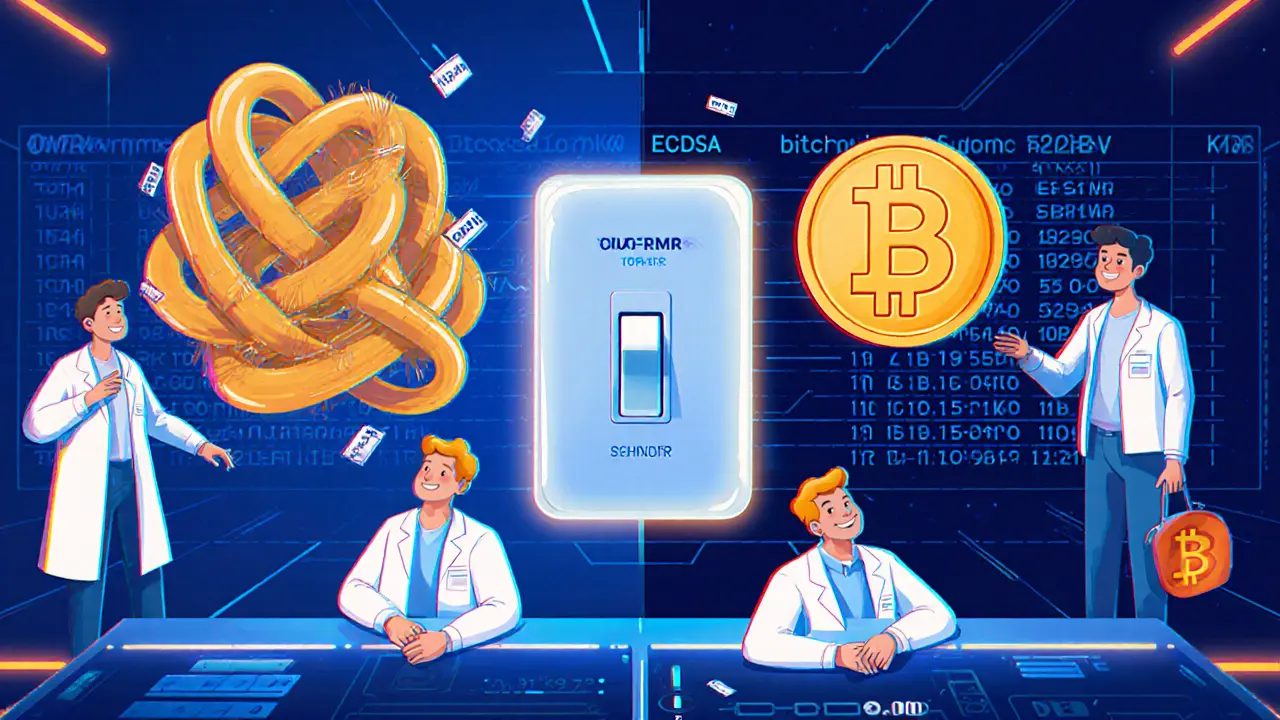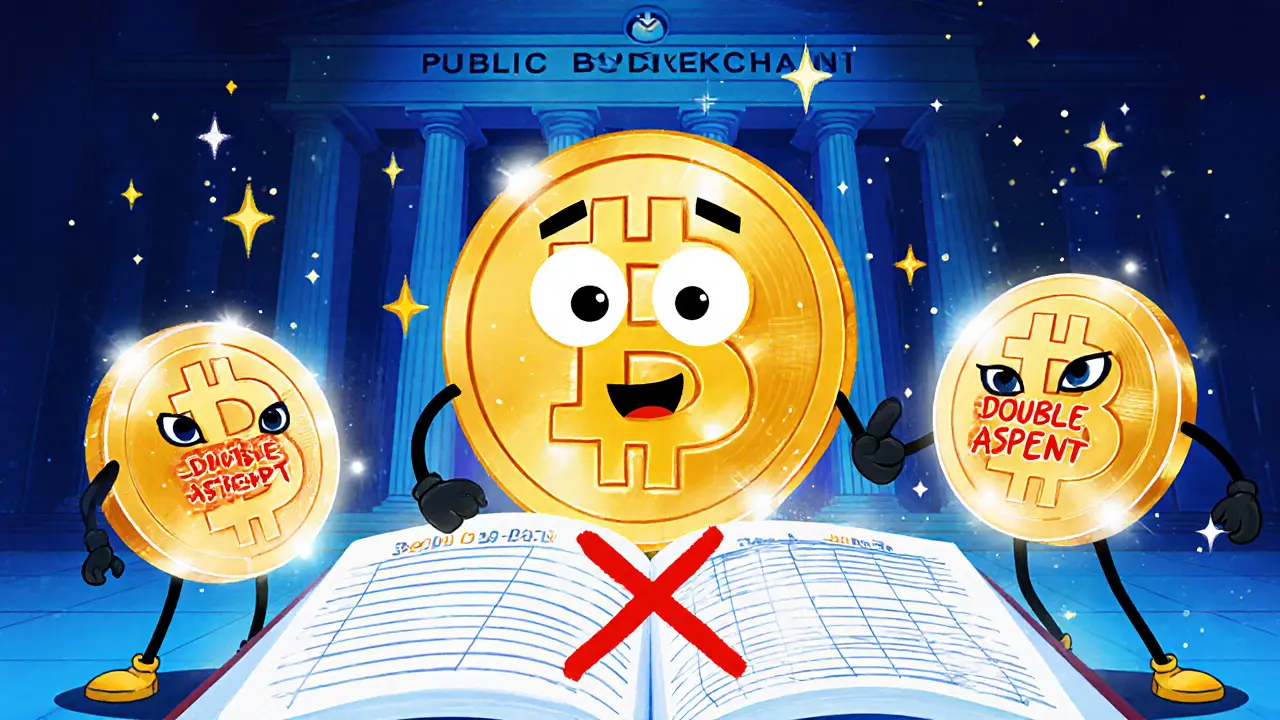
- 28 Oct 2024
- Elara Crowthorne
- 19
Schnorr vs ECDSA Signature Comparison
Performance Comparison
Batch verification is significantly more efficient with Schnorr due to its linear nature.
Privacy Impact
Schnorr: Enables key aggregation (MuSig) that hides multisig participants, making transactions appear as single-sig spends.
ECDSA: Multisig requires exposing all public keys, revealing transaction participants and increasing size.
Implementation Complexity
Schnorr: Simpler codebase with no DER encoding required. Easy to implement securely.
ECDSA: Complex edge-case handling for low-S values, DER parsing, and key-prefixing for security.
Real-World Benefits
Fee Savings: Each signature saves 6-9 bytes, reducing transaction fees.
Scalability: Smaller transactions and batch verification increase block capacity.
Privacy: Key aggregation hides participant information in multisig setups.
When Bitcoin developers introduced Taproot, the most talked‑about change wasn’t a new script language - it was the switch from the decades‑old Schnorr signatures to the more familiar ECDSA. If you’ve ever wondered why the shift matters, what the concrete differences are, and how they affect privacy, fees, and scalability, this guide breaks everything down in plain English.
What the two schemes actually are
Schnorr signatures are a cryptographic signature method based on a linear equation over an elliptic curve. The linear nature lets multiple signers combine their keys into a single aggregate key, making batch verification and key aggregation straightforward.
ECDSA (Elliptic Curve Digital Signature Algorithm) is a non‑linear signature scheme that has been Bitcoin’s default since its launch in 2009. It uses a more complex verification equation and relies on DER encoding, which adds extra bytes to each signature.
Both rely on the discrete logarithm problem for security, so in theory they offer comparable strength. The real divergence is in efficiency, privacy, and how easy they are to implement correctly.
Why Bitcoin switched - the history behind the move
Back in the 1980s, Claus‑Peter Schnorr patented his signature idea. The patent blocked widespread use, prompting the creation of DSA and later ECDSA as work‑arounds. When the patent expired, developers finally had a free‑to‑use alternative. BIP 340, the specification that defines Schnorr signatures for Bitcoin, was baked into the Taproot soft fork in November2021, allowing the network to start using the newer scheme without breaking legacy software.
Size matters - signature and key footprints
Every byte saved translates into lower transaction fees. Here’s a quick look:
| Metric | Schnorr | ECDSA |
|---|---|---|
| Signature size | 64bytes (fixed) | 70‑72bytes (DER encoded) |
| Public key size | 32bytes (x‑coordinate only) | 33bytes (compressed) |
Those 6‑9 byte savings per signature become massive when you’re verifying thousands of inputs in a single block.
Performance - verification speed and batch processing
On a typical modern CPU, verifying a Schnorr signature is about 15% faster than an ECDSA verification. The gap widens dramatically when you batch‑verify many signatures. Because Schnorr signatures are linear, a verifier can add up the underlying point operations, turning 100 separate checks into roughly the work of a handful of checks. ECDSA’s non‑linear equation makes batch verification messy and less efficient.
In practice this means:
- Full‑node operators see lower CPU usage during block validation.
- Wallets that sweep many UTXOs (e.g., coin‑join services) enjoy faster transaction creation.
- Future scaling solutions that rely on massive multi‑input transactions become more viable.

Multisignature and key aggregation - the real game changer
MuSig is a Schnorr‑based protocol that lets multiple parties produce a single aggregated signature. From an on‑chain perspective, an n‑of‑n MuSig transaction looks exactly like a regular single‑sig spend.
Contrast that with Bitcoin’s legacy CHECKMULTISIG approach, which:
- Places every signer’s public key on‑chain, leaking participation data.
- Consumes extra bytes for each individual signature.
- Requires cumbersome script handling.
Security nuances - malleability, nonce handling, and replay protection
Both schemes are vulnerable if the signing nonce is reused, but Schnorr’s design reduces the attack surface:
- Non‑malleability: Schnorr signatures are inherently non‑malleable. An attacker can’t tweak a valid signature into a different one that still verifies.
- Replay protection: The algorithm includes the message hash in a way that prevents simple replay attacks without extra checks.
- Side‑channel resistance: The linear verification path makes constant‑time implementations easier, lowering the risk of timing attacks.
ECSDA, on the other hand, needs extra measures like SIGHASH flags and explicit non‑malleability fixes (e.g., BIP 147) to reach a comparable security posture.
Implementation complexity - why developers prefer Schnorr
Because Schnorr’s math is linear, the reference implementation in BIP 340 fits on a single page of C code, with clear test vectors and no DER parsing. ECDSA, by contrast, includes:
- Complex edge‑case handling for low‑S values.
- DER‑encoding/decoding logic that has historically been a source of bugs.
- Key‑prefixing tricks to avoid rogue‑key attacks in multisig setups.
The simpler code base means fewer chances for subtle security flaws - a crucial factor for wallets and hardware devices that must keep the attack surface minimal.
Scalability impact - fee savings and block‑space efficiency
Every saved byte directly reduces the fee a user pays. When you combine smaller signatures, batch verification, and key aggregation, you get a double‑dip effect:
- Transaction size drops → lower fee per transaction.
- More transactions fit into a block → higher throughput.
For high‑volume services like custodial exchanges or payment processors, the cumulative effect can be thousands of dollars saved per month.

Current ecosystem support - where you’ll see Schnorr today
Since Taproot activation, major wallets (e.g., Bitcoin Core, Electrum, Sparrow) have added optional Schnorr signing. Most exchanges still rely on ECDSA for backward compatibility, but the trend is clear:
- New address types (P2TR) are Schnorr‑only.
- Lightning implementations such as LND and Core Lightning support Schnorr‑based channel establishment.
- Developer libraries (libsecp256k1, bitcoin‑js) expose both schemes, making migration painless.
Full migration will take years, but every new feature built on Taproot automatically benefits from Schnorr’s advantages.
Future directions - threshold signatures and beyond
Advanced protocols like distributed key generation (DKG) lets a group jointly create a shared Schnorr key without exposing individual private components are already being prototyped for enterprise custody solutions. These threshold‑signature schemes enable k‑of‑n signing without ever revealing the underlying public keys, opening a path to even more privacy‑preserving custody.
Researchers are also exploring cross‑transaction aggregation, where signatures from multiple unrelated transactions are combined into a single proof. If that becomes practical, the scaling benefits could be comparable to the shift from traditional blockchains to sharding.
Quick takeaways
- Schnorr signatures are 64bytes, ECDSA is 70‑72bytes.
- Verification is ~15% faster; batch verification scales dramatically better.
- Native key aggregation (MuSig) hides multisig participants and saves space.
- Built‑in non‑malleability and replay protection simplify secure implementations.
- Adoption is growing fast after Taproot, but legacy ECDSA support remains for compatibility.
Frequently Asked Questions
What is the main difference between Schnorr and ECDSA?
Schnorr uses a linear equation that allows key aggregation and simple batch verification, while ECDSA uses a non‑linear equation, making it larger and harder to batch.
Why does Schnorr save bytes?
Schnorr drops DER encoding and compresses the public key to 32bytes, giving a fixed 64‑byte signature versus 70‑72bytes for ECDSA.
Can I use Schnorr signatures today?
Yes. Any wallet that supports Taproot (P2TR) can create Schnorr signatures. Bitcoin Core 24.0 and later include native support.
Is Schnorr more secure than ECDSA?
Both offer comparable cryptographic strength, but Schnorr’s simpler proofs and built‑in non‑malleability reduce the chance of implementation bugs, which is a practical security win.
How does key aggregation improve privacy?
With aggregation, an n‑of‑n multisig appears as a single‑sig spend on the blockchain, so observers can’t tell which subset of keys actually signed.
What is MuSig and why is it important?
MuSig is a protocol built on Schnorr that lets multiple parties produce one aggregated signature. It reduces transaction size, boosts privacy, and speeds up verification.



19 Comments
Great overview of the differences between Schnorr and ECDSA!!! The way you've broken down signature sizes, verification speed, and privacy implications is really helpful, especially for newcomers!!! Keep up the excellent work!!!
Oh sure, because everyone loves a 70‑byte signature, right?
I really appreciate how you laid out the technical details in a way that feels approachable for both engineers and hobbyists.
The side‑by‑side tables make the size differences instantly clear, which is often the first question people have.
Highlighting the 15 % verification speed improvement helps readers see the practical impact on node performance.
Your explanation of batch verification really demystifies why Schnorr can scale better in high‑throughput scenarios.
The discussion of MuSig and how it hides multisig participants adds a compelling privacy angle that many overlook.
I also like how you connected the smaller signature size to actual fee savings for everyday users.
The section on implementation complexity shows that developers will have fewer pitfalls to worry about moving forward.
By pointing out the built‑in non‑malleability of Schnorr, you reassure security‑focused readers about the protocol’s robustness.
Your historical context about the patent expiration gives a nice narrative that ties the technical evolution to real‑world decisions.
I found the comparison of DER encoding versus the fixed‑size format especially useful for understanding why ECDSA occupies more space.
The bullet points summarizing key takeaways at the end serve as a perfect quick reference for anyone revisiting the article later.
It’s also great that you mentioned current wallet support, which helps readers know what they can actually use today.
The future directions you outlined, like threshold signatures, spark curiosity about where Bitcoin scalability might head next.
Overall, the article balances depth and readability, making a complex subject feel less intimidating.
Thanks for putting together such a thorough guide; it will definitely be a go‑to resource for many in the community.
I'm glad you brought up the fee savings angle because that’s what most users notice first.
Every byte you shave off translates directly into a lower transaction cost, especially for high‑volume services.
The batch verification benefits also mean nodes can process more blocks with the same hardware.
By using Schnorr, developers can avoid many of the edge‑case bugs that have plagued ECDSA implementations.
Overall, the practical advantages you listed make a strong case for adopting Schnorr now.
It's almost as if the crypto elite pushed ECDSA for years just to keep the masses locked in a legacy maze, while the real power move was waiting in the shadows for Schnorr to finally break free.
The linear nature of Schnorr feels like a hidden key, a backdoor to privacy that the original designers might have subtly encoded.
One could argue that the timing of Taproot was no coincidence, a coordinated unveiling to shift control away from the old guard.
Either way, the tech itself stands tall, and the narrative around it adds a layer of intrigue that's hard to ignore.
Yo, I cant help but wonder why nobody talks about the hidden backdoors in the code, maybe because the big players dont want us to see the truth.
The way they hype up "faster verification" sounds like a distraction while they push other agendas.
Also, the fact that batch verification is only possible with Schnorr makes me think they wanted to keep the old system fragile.
Just saying, stay skeptical and read the source.
Indeed, the transition from ECDSA to Schnorr represents a pivotal evolution in cryptographic praxis, heralding a new epoch for Bitcoin's scalability.
The gravitas of this shift cannot be overstated, as it reshapes the very foundations of transaction verification.
Such a shift is inevitable, for the truth of progress must prevail over outdated dogma.
Honestly, the article could've cut some of the fluff; the history section felt a bit long.
But the core comparison is solid, and I appreciate the clear tables.
Overall, good job, just trim the excess next time.
The data presented aligns well with the established metrics for signature size and verification cost.
Consequently, the conclusions drawn appear sound and well‑supported.
India's crypto community should back Schnorr fully, it's the future of secure transactions.
Don't let foreign agendas keep us stuck with outdated ECDSA.
Wow amazing insight, really groundbreaking.
Never saw that coming.
Thinking about signatures, it's fascinating how a simple mathematical tweak can ripple through an entire ecosystem.
Each byte saved is a whisper of efficiency, echoing across the network.
When we embrace such elegant solutions, we not only improve performance but also honor the spirit of open collaboration.
Let's keep exploring these subtle yet powerful innovations.
From a protocol engineering standpoint, the reduction in DER overhead directly translates to lower on‑chain data density, enhancing throughput.
Moreover, the linearity of Schnorr aligns seamlessly with existing batch‑verification frameworks, minimizing computational redundancy.
Future developers should therefore prioritize Schnorr integration to maximize both security and scalability.
This article truly moved me!!! The clarity with which you dissected the cryptographic nuances is simply breathtaking!!! Thank you for shedding light on such a crucial topic!!!
Great job!! This guide is super helpful and makes the complex stuff feel approachable!! 😃 Keep spreading the knowledge!! 🎉 The community will definitely benefit from these insights!! 🚀
It's clear that the push for Schnorr is part of a larger agenda to consolidate mining power under a unified narrative, keeping the old ECDSA loyalists in the dark.
The selective promotion of batch verification advantages feels like a strategic move to sideline alternative cryptographic research.
We must stay vigilant and question who truly benefits from this transition.
The points you raised are well‑articulated and add valuable perspective to the discussion.
I look forward to seeing how the ecosystem continues to evolve.
In summary, the migration to Schnorr offers tangible benefits in size, speed, and privacy, which are indispensable for Bitcoin's long‑term viability.
While the technical community has largely embraced these improvements, it remains essential to address any lingering concerns through transparent dialogue.
Adopting Schnorr does not negate the historical contributions of ECDSA, but rather builds upon them.
Let us continue to collaborate across borders and expertise to ensure a smooth transition.
Looking forward to the next milestones! 😊